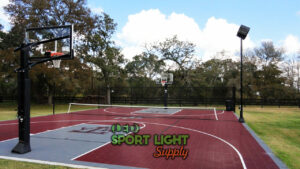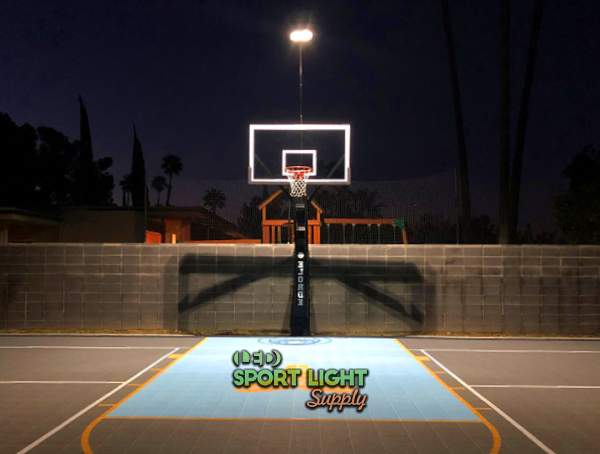
 Solar-powered LED lights are becoming a popular choice for lighting basketball courts due to their environmental benefits, cost savings, and enhanced lighting quality. These innovative systems rely on renewable energy, reduce reliance on fossil fuels, and provide high-quality illumination while cutting down on maintenance and operational costs. As demand for sustainable energy solutions grows, solar-powered LED lighting offers a practical and effective way to illuminate sports facilities while promoting sustainability.
Solar-powered LED lights are becoming a popular choice for lighting basketball courts due to their environmental benefits, cost savings, and enhanced lighting quality. These innovative systems rely on renewable energy, reduce reliance on fossil fuels, and provide high-quality illumination while cutting down on maintenance and operational costs. As demand for sustainable energy solutions grows, solar-powered LED lighting offers a practical and effective way to illuminate sports facilities while promoting sustainability.
Table of Contents
ToggleThe switch to solar-powered LED lighting on basketball courts has a significant positive impact on the environment. Traditional lighting systems typically depend on electricity generated from fossil fuels, which contributes to greenhouse gas emissions and climate change. Solar lights, on the other hand, harness energy from the sun, a renewable resource, drastically reducing the carbon footprint of the facility. The transition to solar energy not only helps to mitigate the negative effects of climate change but also reduces the strain on nonrenewable energy sources.
In addition to using renewable energy, LED technology contributes further to environmental sustainability. LED lights are far more energy-efficient than their incandescent or fluorescent counterparts. While traditional lights often waste a substantial amount of energy in the form of heat, LEDs convert a higher percentage of energy into light, making them more effective and less wasteful. This greater efficiency means fewer resources are consumed to achieve the desired lighting levels, which in turn results in lower energy consumption over time.
 Investing in solar-powered LED lighting systems can have higher upfront costs compared to traditional lighting methods. However, over time, the savings far outweigh the initial investment. One of the primary advantages of solar-powered lights is that they eliminate the need for monthly electricity bills, which can significantly reduce operational expenses. Solar energy is free, and by using it to power the lighting system, the need for external power sources is eliminated. This translates to long-term savings for basketball court operators and owners.
Investing in solar-powered LED lighting systems can have higher upfront costs compared to traditional lighting methods. However, over time, the savings far outweigh the initial investment. One of the primary advantages of solar-powered lights is that they eliminate the need for monthly electricity bills, which can significantly reduce operational expenses. Solar energy is free, and by using it to power the lighting system, the need for external power sources is eliminated. This translates to long-term savings for basketball court operators and owners.
The long lifespan of LED lights adds to their cost-effectiveness. Traditional lighting systems often require frequent bulb replacements, resulting in additional maintenance and replacement costs. LED lights, however, are known for their durability, lasting much longer than conventional bulbs. This extended lifespan means that the need for replacement is far less frequent, which lowers maintenance costs and helps owners save money in the long run.
Additionally, solar-powered LED lighting systems typically have lower maintenance requirements compared to other lighting setups. With fewer parts that wear out and the absence of costly energy bills, these systems provide a more affordable option over time. As technology advances and more efficient systems are developed, these cost savings will only increase, making solar-powered LED lighting even more appealing.
One of the standout features of solar-powered LED lights is their high lighting quality. LED lights produce bright, uniform illumination that ensures excellent visibility on the court, which is crucial for both players and spectators. Unlike older lighting technologies that can result in uneven lighting or harsh glares, LEDs provide consistent brightness across the playing area, enhancing the overall experience for everyone involved.
The color rendering index (CRI) of LED lights is another factor that contributes to their superior lighting quality. A higher CRI means that colors appear more natural and true to life under the lights. For players, this accurate color representation is beneficial for tracking the ball and judging distances on the court. For spectators, it ensures a visually pleasant experience, making the action on the court more enjoyable to watch. With their superior color accuracy and consistent light output, LEDs improve the performance environment for athletes and create a better atmosphere for fans.
Additionally, LEDs are highly adaptable, allowing the lighting system to be customized to suit the specific needs of the basketball court. Whether the aim is to create bright lighting for a competitive game or softer lighting for recreational play, the ability to fine-tune the light intensity makes LEDs a versatile solution for various scenarios.
To ensure the successful installation of solar-powered LED lighting, a thorough site assessment is necessary. Several factors must be considered to ensure that the system operates at its optimal capacity. One of the most significant considerations is the amount of sunlight the court receives. The effectiveness of a solar lighting system depends on the amount of solar energy that can be captured by the panels. This means the geographical location of the court, along with the time of year and local climate conditions, plays a key role in determining how much energy can be harnessed from the sun.
Shading from nearby structures such as trees or buildings can also affect the amount of sunlight available for the solar panels. It is essential to assess whether the court is situated in an area where sunlight is unobstructed for a significant portion of the day. If shading is an issue, it may be necessary to adjust the placement of the solar panels or consider additional solutions to optimize energy capture.
The layout of the court itself also impacts the design and efficiency of the lighting system. A proper site assessment helps identify the best locations for installing solar panels and placing LED fixtures to achieve optimal lighting. By taking all these factors into account, the lighting system can be tailored to meet the specific needs of the court and ensure that it operates efficiently throughout the day and night.
The design of a solar-powered LED lighting system is a crucial step in ensuring its effectiveness and efficiency. Selecting the right fixtures is a key aspect of this process. The LED lights chosen must be capable of delivering the required illumination levels for the basketball court. For a regulation-size basketball court, specific lumens per square meter are necessary to ensure the playing surface is adequately lit for both competitive play and recreational use. The design process includes calculating the correct amount of lighting for the area to achieve a balance between adequate brightness and energy efficiency.
In addition to the LED fixtures, a solar panel array must be designed to meet the energy needs of the lighting system. This involves determining how many panels are needed to generate enough electricity to power the lights throughout the night. The solar panels should be positioned in a way that maximizes their exposure to sunlight, taking into account the factors identified during the site assessment. The system must also include a battery storage solution to store energy generated during the day, ensuring that the lights can function during the night when sunlight is not available.
By carefully designing the system to meet the specific energy and lighting requirements of the basketball court, the solar-powered LED lighting solution can deliver reliable and efficient performance for years to come.
Solar-powered LED lighting systems are designed with durability in mind, making them a low-maintenance option for sports facilities. These systems are built to withstand the elements, with weather-resistant components that can function reliably in various outdoor conditions. Unlike traditional lighting setups that may require frequent bulb replacements or repairs, solar-powered LEDs require minimal attention after installation.
Regular maintenance mainly consists of ensuring that the solar panels are clean and unobstructed. Dust, dirt, or debris on the panels can reduce their ability to capture sunlight and generate energy. Simple inspections to check for any blockages or buildup will help maintain the system’s efficiency. In addition, the batteries that store solar energy should be checked periodically to ensure they are functioning correctly and holding a charge.
By investing in proper maintenance, the lifespan of the solar-powered LED lighting system can be extended, allowing it to provide reliable service for many years. The durability of LED lights and solar panels means that, with minimal upkeep, the system can continue to operate at peak performance long after installation.
Solar-powered LED lights are a smart and sustainable solution for lighting basketball courts. Their environmental benefits, long-term cost savings, and high-quality lighting make them an excellent choice for modern sports facilities. By switching to solar energy, sports venues can significantly reduce their carbon footprint, lower operational costs, and improve the overall experience for players and spectators. With careful site assessment, thoughtful system design, and minimal maintenance, solar-powered LED lighting can provide a reliable and cost-effective solution that benefits both the environment and the community.
Drop us a line to receive a free lighting design